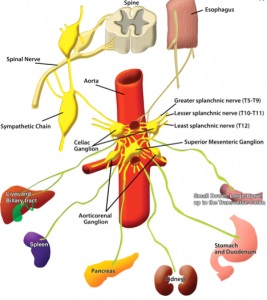What is a celiac plexus block?
A celiac plexus nerve block is an injection procedure utilized in pain management to either diagnose or treat abdominal pain due to such things as Pancreatitis, Cancer , Crohn’s disease or other abdominal source like Inflammatory Bowel Disorder (IBD).
, Crohn’s disease or other abdominal source like Inflammatory Bowel Disorder (IBD).
The theory behind a celiac plexus block is to block the nerves that transmit signals from the abdomen to the brain, thereby reducing the patient’s discomfort by preventing the brain from receiving those painful signals.
What exactly is the celiac plexus?
This is a bundle of nerves that are situated in front of the diaphragm and in back of the stomach near the aorta and surrounding the celiac artery. The bundle of nerves supplies sensation to the liver, stomach, intestines, adrenal glands, gallbladder, spleen, kidneys and a significant amount of blood vessels.
For what conditions is a celiac plexus block effective as a treatment?
When a person is having pain from one of the abdominal organs, the celiac plexus block may relieve this discomfort. For instance, an individual with pancreatic cancer may not respond well to opiate medications, but a celiac plexus block may be great for pain relief. In addition, the procedure may provide excellent relief to individuals dealing with intractable pain from other abdominal cancers in the upper region. Another condition that receives excellent benefit from a celiac plexus block is pancreatitis.
Call (602) 507 – 6550 to schedule your Appointment TODAY!


Celiac Plexus provides sensation to a lot of organs
How is the procedure performed?
A celiac plexus block is typically performed as an outpatient procedure with most commonly the patient laying flat on the abdomen. The patient may receive IV sedation for the procedure but this is not absolutely necessary. It is good for those who have anxiety issues or excessive pain just from laying on the table. The pain doctor will numb up the skin and the soft tissue track leading from the back down to the spinal area.
The most common method for the procedure is to actually treat the celiac plexus with not one, but two separate needles so that both sides of the celiac plexus may be treated most effectively. The Arizona pain management doctor performing the procedure will utilize a real-time x-ray machine known as fluoroscopy to ensure the most accurate needle positioning possible.
Often times, once the needle is in satisfactory position the physician will inject contrast dye to make sure it is not situated in a blood vessel. At this point numbing medicine is injected through both needles to block the pain signals going from the celiac plexus to the patient’s brain. The procedure may be performed as a diagnostic procedure to see if it is going to work simply with numbing medicine. If the results are beneficial, a longer-lasting medication can be injected such as alcohol or phenol to destroy the celiac plexus nerves and provide longer-lasting pain relief. The procedure usually takes around 30 minutes and the patient is monitored afterwords for an hour or so to ensure stable vital signs prior to being discharged.
How well does a celiac plexus nerve block procedure work?
These blocks may work exceptionally well for pancreatitis or cancer or other abdominal organ dysfunction. Research has shown that they produce excellent pain control with a
decreased need for pain medication compared with standard treatment when it comes to pancreatic cancer. Approximately 75% of patients receive excellent pain relief for two to four months (Rykowski et al, Anesthesiology 2000). Considering that the procedure has a fairly low risk profile and is minimally invasive, it fits in nicely with a nonoperative approach for patients dealing with a significant suffering condition.
What are the risks of a celiac plexus nerve block?
When it comes to individuals suffering from severe abdominal pain, these blocks may work wonderfully. The risk profile for the procedure is low, but it cannot be ignored. There is a risk of infection, bleeding, collapsed lung, arterial puncture, nerve damage or drug allergy. There can also be a reaction from the injected medication or from IV sedation or very rarely paralysis. Most commonly the patient may have transient hypotension which is a decrease in blood pressure, or transient diarrhea.
Overall what are the outcomes from these plexus blocks?
For patients suffering from chronic abdominal pain, these blocks may provide substantially decreased need for opiate medications. When an individual has cancer of the liver, gallbladder, G.I. tract, pancreas or other abdominal organ, pain medications often do not work exceptionally well. The celiac plexus block on the other hand, is often extremely effective in getting weeks to months of pain relief in approximately 75% of patients (Rykowski et al, Anesthesiology 2000). If the celiac plexus block works for a few weeks to a few months and then the pain relief wears off, it may be repeated again as an outpatient procedure.
Studies have also shown that celiac plexus blocks can substantially decrease the amount of pain medication necessary to provide adequate abdominal pain relief. Since opiate medications often do not provide satisfactory pain relief for abdominal pain, a celiac plexus block is an extremely valuable tool for pain control (Okuyama et al, J Hepatobiliary Pancreat Surg 2002).
For those individuals suffering with chronic abdominal pain who live in Arizona, Arizona Pain Specialists offers Double Board Certified, Fellowship Trained pain management doctors who are experts in this procedure. It is a specialized procedure so often times patients come from around the state to be treated by Arizona Pain.
Call (602) 507 – 6550 to schedule your Appointment TODAY!

![]()


 , Crohn’s disease or other abdominal source like Inflammatory Bowel Disorder (IBD).
, Crohn’s disease or other abdominal source like Inflammatory Bowel Disorder (IBD).